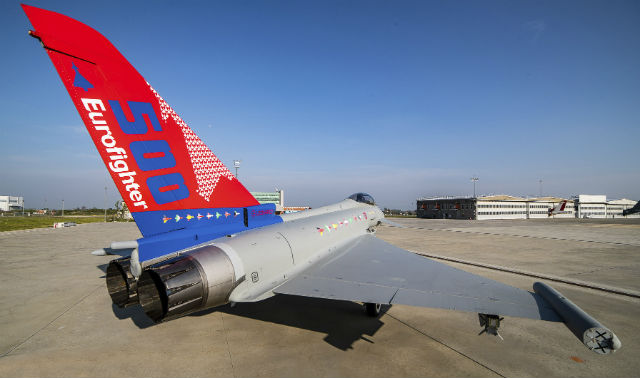Eurofighter now has only 99 Typhoons left to deliver in order to fulfil its current orders, and while the four-nation industrial consortium is actively seeking new customers for the type, measures have been put in place to slow its production rate.
Kuwait – the most recent customer for the multirole fighter – is due to receive the last of 28 contracted Typhoons in 2023, at which point the Eurofighter final assembly lines will cease to manufacture the aircraft in the absence of further customers.
Partner companies Airbus Defence & Space, BAE Systems and Leonardo Aircraft could produce the remaining aircraft at a faster rate, but have opted to reduce annual output to allow more time to attract additional orders.
Between 2009 and 2013, an average of 50 Eurofighters were produced per year. After handing over the programme's first example to the UK in late 2003, a 200th delivery was made to Spain in 2009, while the 400th went to the Germany in 2013. It took another four years until the 500th Typhoon was transferred to the Italian air force on 11 April.

Eurofighter
This recent level of activity, delivering an average of 25 aircraft per year, contrasts with the programme's peak production rate in 2010, when 60 Typhoons were delivered.
Eurofighter is committed to rolling out upgrades for existing operators of the type, and is due to begin implementing the P3E operating standard. This includes weapon options including the MBDA Brimstone 2, Meteor and Storm Shadow missiles, plus the Euroradar consortium's Captor-E active electronically scanned array (AESA) radar during its P3EB configuration, the development of which is being led by Leonardo.
Kuwait will receive all these features with its aircraft, having notably become the first nation to commit to acquiring the AESA radar.
Eurofighter and Leonardo are currently carrying out flight testing of the radar in Scotland using one development aircraft, and plans are in place to carry out trials on a German-owned example next year. The radar is being powered up during this test phase, but is not yet emitting.
Partner nations Germany, Italy, Spain and the UK have funded the development of the radar, but have yet to buy it for their own fleets. Typhoons in service today use a Leonardo-developed mechanically scanned radar, which Eurofighter claims is sufficient for current operations, meaning there is no immediate rush to upgrade to an AESA product.
A combined requirement to field the active array design is likely to emerge to support operations around the early 2020s, according to one industry source. The Italian air force's programme chief, Col Andrea Truppo, backs this schedule, noting that the service's Tranche 3-standard aircraft are likely to receive the update. Rome has yet to decide whether to also apply it to its Tranche 2 examples, he adds.
Discussions are under way regarding a future P4E operating standard, although Eurofighter chief executive Volker Paltzo declines to identify which updates this could introduce.
"We still have some debating left to do on the definition phase for this," Paltzo said during a delivery event for the programme's 500th aircraft in Turin. This process is likely to be complete in the June/July timeframe, he believes, with a contract expected to be signed during 2018.
Tranche 1-standard examples of the Typhoon will remain serviceable until they have either amassed 6,000 flight hours or been operational for 25 years, Paltzo says, and an "ongoing debate" concerns life-extension options.
Paltzo acknowledges that the annual production rate is being assessed within Eurofighter, but he declines to detail what the output will be each year until the end of the programme.
“Of course, we hope for more orders,” he says. “It is going to be a steady flow of production, but at a lower rate.”
Further ahead, the consortium is already considering what subsequent P5E and P6E standards could look like. Paltzo reveals only that such phases will focus on network-centric operations, and notes that the long-term view is representative of its commitment to keep the programme going into the 2040s.
Kuwait's contract – signed via the Italian government and with final assembly by Leonardo – includes three years of support from delivery of the first aircraft, plus in-country infrastructure and training. The Gulf state's first batch of pilots has already been trained, Eurofighter says.
Source: Flight International



















